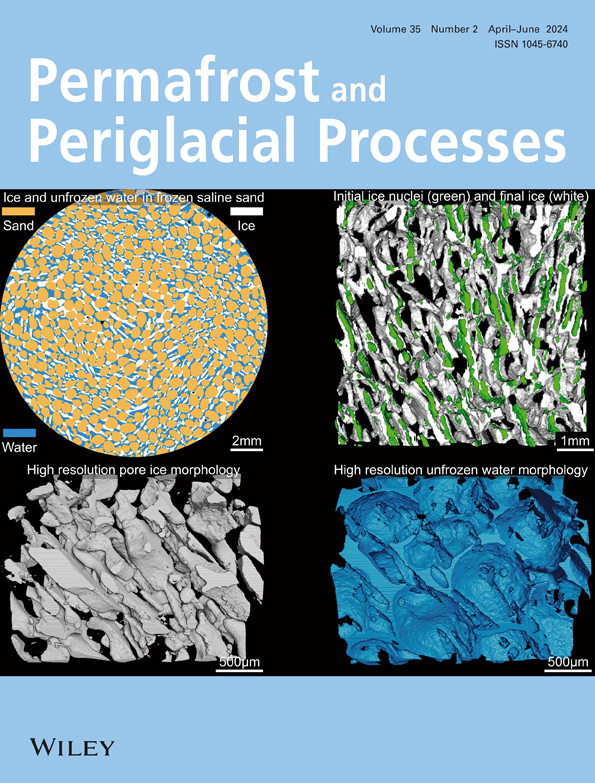热岩溶过程增加了矿物-有机碳相互作用的稳定表面和元素(Fe、Mn、Al和Ca)的供应
IF 3.3
3区 地球科学
Q2 GEOGRAPHY, PHYSICAL
引用次数: 4
摘要
矿物-有机碳(OC)相互作用的稳定特性已在许多土壤环境中进行了研究(温带土壤、波德唑红土和水稻土)。最近,随着多年冻土被确定为变化热点,人们对它们在多年冻土地区的作用越来越感兴趣。在融化的富冰永久冻土区,如Yedoma地区,327–466 Gt的冷冻OC埋在深层沉积物中。矿物和OC之间的相互作用很重要,因为OC位于矿物基质附近。矿物表面和元素可以通过对OC的物理和/或物理化学保护来减少最近和未来的温室气体排放。与热岩溶湖泊形成和排水相关的氧化还原和pH条件的动态变化触发了金属氧化物的溶解和沉淀,可能影响OC的稳定和微生物矿化。然而,热岩溶过程对矿物-有机碳相互作用的影响仍然很有限。在本研究中,我们旨在表征Fe、Mn、Al和Ca矿物及其对OC的潜在保护作用。使用总萃取和选择性萃取来评估结晶和无定形氧化物或络合金属池以及在这些池中发现的有机酸。我们分析了雅库特中部富含冰的永久冻土区的四个沉积物岩心,这些岩心是(i)在未受干扰的耶多马高地上钻探的,(ii)在耶多马沉积物中形成的最近的湖泊下钻探的;(iii)在排水的热岩溶湖盆中钻探的;以及(iv)在全新世早期成熟的热岩溶湖下钻探的。我们发现湖泊形成时沉积物中活性Fe、Mn、Al和Ca的含量减少(促进还原反应),这在很大程度上被湖泊排水沉积物中活性金属含量的增加所平衡(促进氧化反应)。我们证明,在热岩溶过程中,金属与碳的摩尔比增加,这可能表明金属与碳结合增加,并可能对有机物的微生物矿化提供更高的保护作用。最后,我们发现矿物-有机碳相互作用的增加对应于热岩溶过程中CO2和CH4气体排放的减少。一旦湖泊排水,矿物-有机碳的相互作用可以减少永久冻土融化产生的温室气体。本文章由计算机程序翻译,如有差异,请以英文原文为准。
Thermokarst processes increase the supply of stabilizing surfaces and elements (Fe, Mn, Al, and Ca) for mineral–organic carbon interactions
The stabilizing properties of mineral–organic carbon (OC) interactions have been studied in many soil environments (temperate soils, podzol lateritic soils, and paddy soils). Recently, interest in their role in permafrost regions is increasing as permafrost was identified as a hotspot of change. In thawing ice‐rich permafrost regions, such as the Yedoma domain, 327–466 Gt of frozen OC is buried in deep sediments. Interactions between minerals and OC are important because OC is located very near the mineral matrix. Mineral surfaces and elements could mitigate recent and future greenhouse gas emissions through physical and/or physicochemical protection of OC. The dynamic changes in redox and pH conditions associated with thermokarst lake formation and drainage trigger metal‐oxide dissolution and precipitation, likely influencing OC stabilization and microbial mineralization. However, the influence of thermokarst processes on mineral–OC interactions remains poorly constrained. In this study, we aim to characterize Fe, Mn, Al, and Ca minerals and their potential protective role for OC. Total and selective extractions were used to assess the crystalline and amorphous oxides or complexed metal pools as well as the organic acids found within these pools. We analyzed four sediment cores from an ice‐rich permafrost area in Central Yakutia, which were drilled (i) in undisturbed Yedoma uplands, (ii) beneath a recent lake formed within Yedoma deposits, (iii) in a drained thermokarst lake basin, and (iv) beneath a mature thermokarst lake from the early Holocene period. We find a decrease in the amount of reactive Fe, Mn, Al, and Ca in the deposits on lake formation (promoting reduction reactions), and this was largely balanced by an increase in the amount of reactive metals in the deposits on lake drainage (promoting oxidation reactions). We demonstrate an increase in the metal to C molar ratio on thermokarst process, which may indicate an increase in metal–C bindings and could provide a higher protective role against microbial mineralization of organic matter. Finally, we find that an increase in mineral–OC interactions corresponded to a decrease in CO2 and CH4 gas emissions on thermokarst process. Mineral–OC interactions could mitigate greenhouse gas production from permafrost thaw as soon as lake drainage occurs.
求助全文
通过发布文献求助,成功后即可免费获取论文全文。
去求助
来源期刊
CiteScore
9.70
自引率
8.00%
发文量
43
审稿时长
>12 weeks
期刊介绍:
Permafrost and Periglacial Processes is an international journal dedicated to the rapid publication of scientific and technical papers concerned with earth surface cryogenic processes, landforms and sediments present in a variety of (Sub) Arctic, Antarctic and High Mountain environments. It provides an efficient vehicle of communication amongst those with an interest in the cold, non-glacial geosciences. The focus is on (1) original research based on geomorphological, hydrological, sedimentological, geotechnical and engineering aspects of these areas and (2) original research carried out upon relict features where the objective has been to reconstruct the nature of the processes and/or palaeoenvironments which gave rise to these features, as opposed to purely stratigraphical considerations. The journal also publishes short communications, reviews, discussions and book reviews. The high scientific standard, interdisciplinary character and worldwide representation of PPP are maintained by regional editorial support and a rigorous refereeing system.

 求助内容:
求助内容: 应助结果提醒方式:
应助结果提醒方式:


